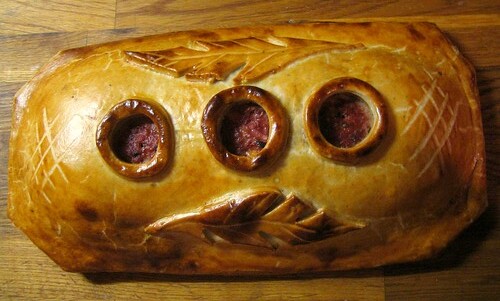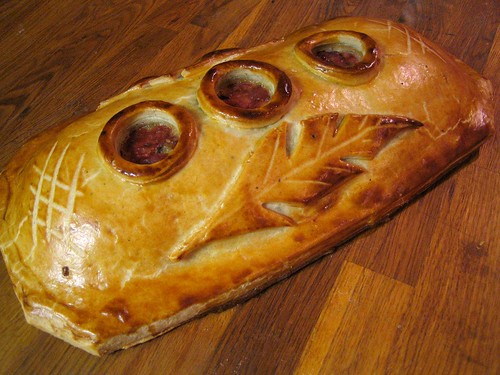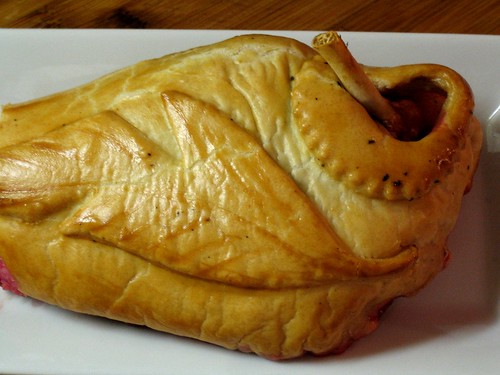Pâté Pantin, édition speciale Volaille.
Freeform poultry pâté in a savory shortcrust pastry.
Much better improvement on the previous pâté. The forcemeat contained duck breast trimmings, chicken leg, chicken and pork liver, chicken gizzards, chicken hearts, fatback, celery and carrot. The duck, chicken thighs, liver and heart were ground with garlic and rosemary and half was puréed. The drumsticks were poached along with the gizzard. The cooked drumstick meat, gizzard, diced fatback, mortar crushed peppercorns as well as diced celery and carrot from the poaching aromatics were folded into the forcemeat. The forcemeat had a pleasant pinkish color and tighter texture than the previous effort. It was far leaner and shrunk far less, consequently leeching less liquid, though it remained moist.
The dough was significantly better as well. Much sturdier though initially overwork in an effort to save it after erroneously using only half of the required water. The dough was rolled thicker and the seams were along the edge of the forcemeat rather than underneath as in the previous. The leaner forcemeat also helped maintain the integrity of the crust and it did not have to absorb/retain any cooking liquid.
Aesthetically the decorative feathers were successful though fluted chimneys would have been more classical. Cross hatches were made after 4 coats of egg-wash with the point of a knife. Not entirely necessary, more of a impulse and effort to keep the ends from being boringly bare.

Ultimately the pâté was well within the spectrum of success. The cooked forcemeat had good texture, taste and appearance as did the pastry. However, a few issues need to be resolved.
Shortcomings and accountability:
Forcemeat: The puréed portion of the forcemeat could have been smoother. It was ground once through the small die and then pulverized in the food processor. A smoother product could have been attained by either grinding the meat twice or more, or putting it in a blender (which I do not currently own) and then passing through a sieve. I was hesitant to pass the meat through a sieve as it is difficult to clean out the sinew and such afterwards.
Shortcrust: The amount of water called for in the recipe formulated from classical French resources looked excessive and roughly half was carelessly omitted since it looked too wet. As a result the dough was dry and brittle and broke apart when folded or stretched. In an effort to salvage the dough, more water was incorporated and naturally it became overworked and elastic making it difficult to work with.
Aspic: Not strong enough, melted at room temperature, again. It later came to my attention that gelatin sheets cancel out any natural gelatin in a consommé or stock and that a proper aspic should be made with 2% gelatin by weight.






